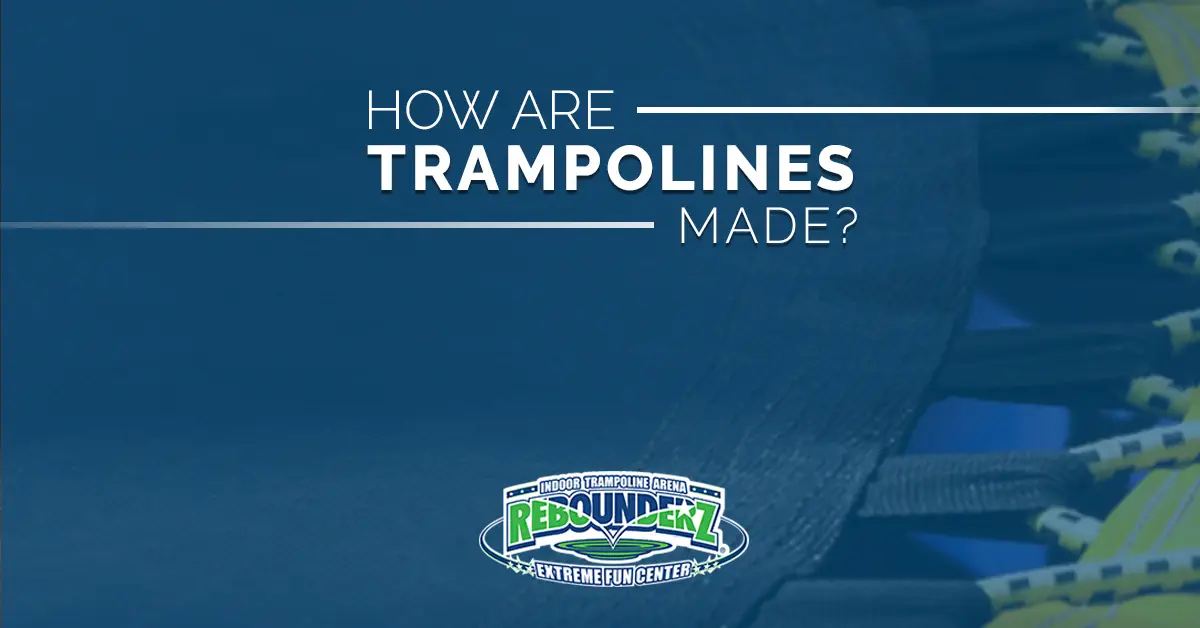ENJOY FREE ADMISSION EVERY DAY WHEN YOU PURCHASE A REBOUNDERZ MEMBERSHIP!

Call Us Now: (833) 832-1255
ENJOY FREE ADMISSION EVERY DAY WHEN YOU PURCHASE A REBOUNDERZ MEMBERSHIP!

Call Us Now: (833) 832-1255

Your kids ask you a lot of difficult questions. Some, harder to answer than others. For example, the feared “birds and bees” question. Every parent anticipates the day that their children ask, “How are babies made?” You know the answer, but you don’t want to tell them! However, your kids can also ask you more difficult questions — questions that you can’t answer because you don’t know. On the slight chance they ask you how trampolines are made, this blog can help you!
So, how are trampolines made?
Trampolines are made with four basic components: springs, tubing, safety pads, and canvas fabric. All of these parts come together in six easy steps.
Step 1: The first step primarily concerns building and bending the tubing to resemble the frame. The tubing is taken to a bending jig in the factory and bent to the prescribed shape. Trampolines come in all shapes and sizes, so the purpose of the trampoline determines how much tubing is needed and how it will be shaped.
Step 2: After bending is complete, the steel is moved to a hole punching machine where holes are put into the sides for the springs.
Step 3: In step three, a welder places sockets into the steel to ensure that the U-shaped legs can fit the estimated size of the frame. Once the tubing has been treated, the four pieces are then connected. When connected, all four of the parts create a circular design. Most trampolines come in the designated circular shape, however at some bigger trampoline venues, the shape can become massive and rectangular.
Step 4: The jumping mat or canvas cover of the trampoline is often woven together at a separate factory. Shipments of the fabric are then delivered to the trampoline factory for cutting. Once the canvas is cut, industrial sewing machines edge the fabric and reinforce the material with web strapping to ensure stability. D- rings, tie-down metal rings, are also sewn onto the fabric to hold the canvas to the trampoline frame.
Step 5: Foam padding is then attached to the frame. Foam padding is a safety protocol implemented by most trampoline manufacturers. Due the the frame’s exposed steel tubing causing safety hazards, most trampolines come installed with protective foam coverings. These pads are made with vinyl covers and leather ties called pie straps. The straps are then sewn to the foam coverings to ensure they don’t slide or fall off the trampoline while jumping.
Step 6: Despite all the other parts needing additional manufacturing features, the springs in fact do not need any other processes. All they need is to be ordered in the proper size and amount. After they are ordered they can be packaged with the other parts and shipped off to their purchaser.
We hope this blog has been helpful, as well as educational. So on the slight chance your children ask you about trampolines, you don’t have to hesitate for a correct answer. While they are on the topic of trampolines, you should also visit your local indoor trampoline park. See trampolines at work at your local Rebounderz! Contact us!